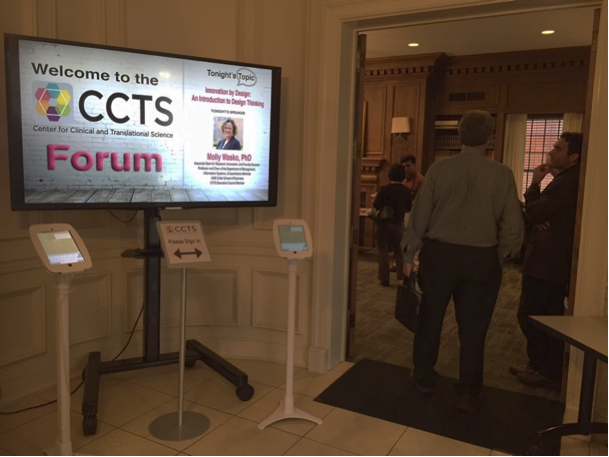 The Stanford d.school approach to problem-solving focuses on the human element. Each of the five steps in the process—empathize, define, ideate, prototype, and test—stresses the importance of keeping the end user in the forefront of the mind. “Design Thinking seeks to understand the future user of a solution and refine ideas based on future users’ feedback,” said CCTS Executive Council Member UAB Associate Dean for Research, Innovation, and Faculty Success; CCTS Executive Council Member; and Stanford d.school expert Dr. Molly Wasko, who facilitated the Oct. CCTS Forum.
The Stanford d.school approach to problem-solving focuses on the human element. Each of the five steps in the process—empathize, define, ideate, prototype, and test—stresses the importance of keeping the end user in the forefront of the mind. “Design Thinking seeks to understand the future user of a solution and refine ideas based on future users’ feedback,” said CCTS Executive Council Member UAB Associate Dean for Research, Innovation, and Faculty Success; CCTS Executive Council Member; and Stanford d.school expert Dr. Molly Wasko, who facilitated the Oct. CCTS Forum.
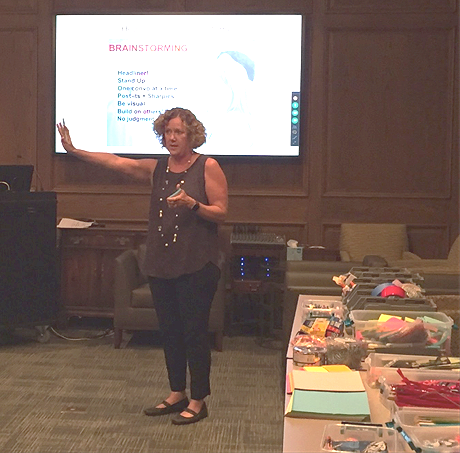 UAB Associate Dean for Research, Innovation, and Faculty Success, Dr. Molly Wasko, explains the design thinking approach to brainstorming.Wasko greeted Forum attendees in the PCAMS library, which was emptied of furniture except for a long table covered in art supplies. She explained the challenge of the next hour was to come up with novel ways to train early stage investigators, building off of insights gleaned from interviews conducted by CCTS Executive Council members. She then laid out the ground rules for design thinking:
UAB Associate Dean for Research, Innovation, and Faculty Success, Dr. Molly Wasko, explains the design thinking approach to brainstorming.Wasko greeted Forum attendees in the PCAMS library, which was emptied of furniture except for a long table covered in art supplies. She explained the challenge of the next hour was to come up with novel ways to train early stage investigators, building off of insights gleaned from interviews conducted by CCTS Executive Council members. She then laid out the ground rules for design thinking:
- Fail is not a four-letter “F word,” but a way to learn quickly.
- Go ahead and try something new with an open mind.
- Champion others’ ideas—it’s even more fun than winning!
Ideation (e.g., brainstorming) is important to encourage teams to step beyond the obvious, work together in a positive fashion, and so increase the innovative potential of their solution set. “The ideate step helps you harness the collective perspectives and strengths of your team and uncover new territory to explore,” explained Wasko.
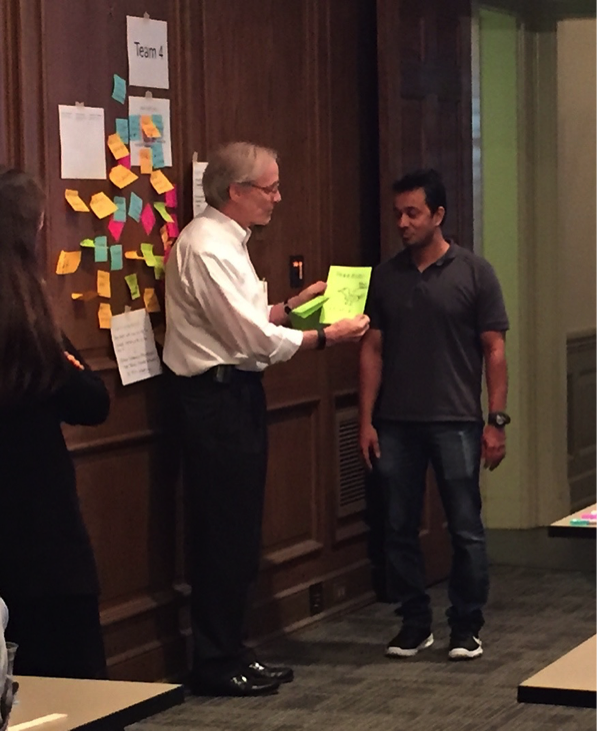 CCTS Director Dr. Robert Kimberly presents a “translational passport” to his teammate.
CCTS Director Dr. Robert Kimberly presents a “translational passport” to his teammate.
The design thinking approach to ideation is kinetic, collaborative, and visual, so Forum attendees were divided into teams standing around the PCAMS library walls. They were armed with stickies, sharpies, and supportive attitudes, instructed to hold only one conversation at a time and to use “yes, and” rather than “yes, but” language. After 12 minutes of brainstorming, team members voted for the ideas that were their “favorite,” “most radical,” and “most likely to thrill the end user.”
For the next step, prototyping, Wasko encouraged Forum attendees to partake of the art supplies and create rough mock-ups of their most popular idea. She encouraged teams to build props and plan a skit to act out their idea, “as the goal is to enable the end user to interact with and experience it,” she said. The teams then took turns demonstrating their prototypes, which included:
- Membership in a “translational clubhouse,” with benefits including a t-shirt, next-gen tech, and a chance to meet with CCTS Director Dr. Robert Kimberly
- A “translational passport” for mini-sabbaticals spent with a clinical or translational researcher in another country
- A clinical and translational research “hotline” that would function as a concierge service for early-stage investigators: answering questions, finding collaborators, and offering mentorship and support
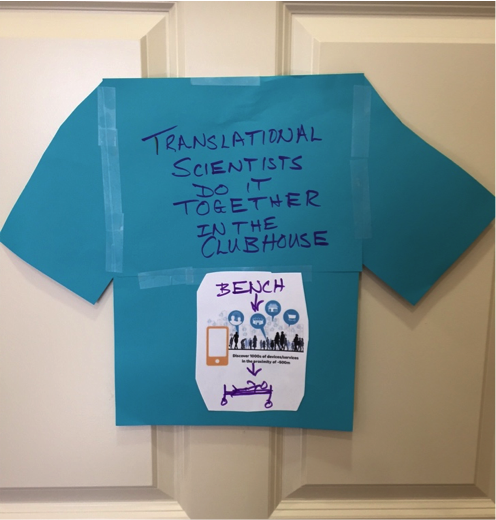 The “sexy t-shirt” designed for early investigators who become members of Team 1’s “translational clubhouse.”The takeaway message, Wasko said, is “When trying to solve problems, think in terms of version 1.0, 2.0, etc.—versions leading toward a solution rather than trying to develop the ‘perfect’ solution. The beauty of this approach is it results in more openness to change.” [Editor’s note: It is also a lot of fun!]
The “sexy t-shirt” designed for early investigators who become members of Team 1’s “translational clubhouse.”The takeaway message, Wasko said, is “When trying to solve problems, think in terms of version 1.0, 2.0, etc.—versions leading toward a solution rather than trying to develop the ‘perfect’ solution. The beauty of this approach is it results in more openness to change.” [Editor’s note: It is also a lot of fun!]
Mark your calendar for our next CCTS Monthly Forum and visit our events page for other exciting CCTS learning opportunities.
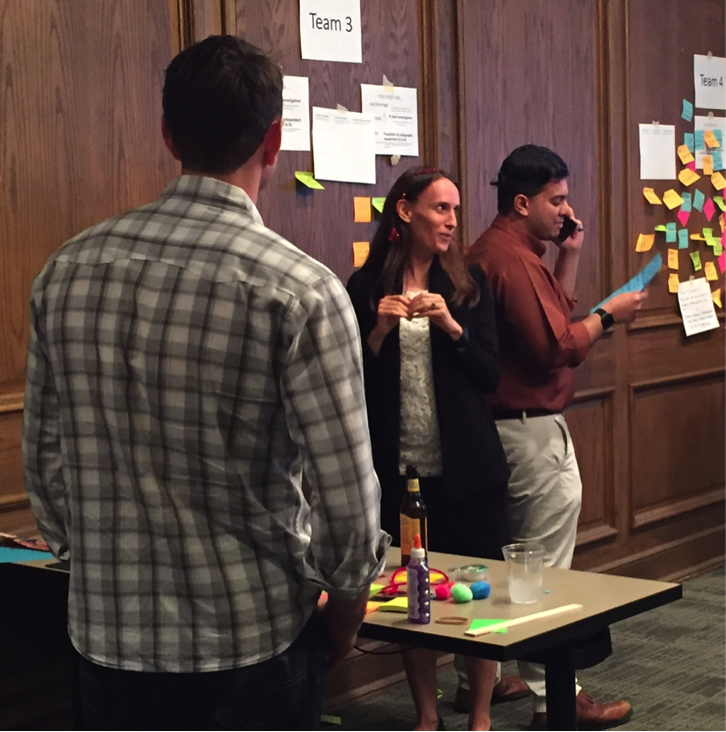 Members of Team 3 act out the “clinical and translational research hotline."
Members of Team 3 act out the “clinical and translational research hotline."